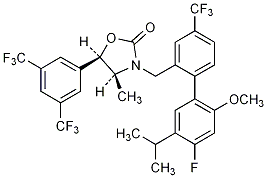ANACETRAPIB molecule:

- molecular formula: C 30 H 25 F 10 NO 3
- IUPAC name: (4S,5R)-5-[3,5-bis(trifluoromethyl)phenyl]-3-({2-[4-fluoro-2-methoxy-5-(propan-2-yl)phenyl]- 5-(trifluoromethyl)phenyl}methyl)-4-methyl-1,3-oxazolidin-2-one
CETP: the target enzyme:
CETP (Cholesterol Ester Transfer Protein) is a boomerang shaped enzyme of 476 amino acid protein (74 kDa) with a highly hydrophobic amino acid content and four N-linked glycosylation sites.

CETP is both involved in lipoproteins Triglycerides/Cholesterol esters transfering (when secrete in the blood) and cell (like adipocyte) uptaking of cholesterol esters from HDL.
The enzyme is also expressed in the Liver, spleen, and small intestine cells of humans and primates. The gene expression is controlled by both endogen and dietary cholesterol which seems to act by triggering retinoid receptor in epatocytes.
The role of plasma lipid transfer proteins in lipoprotein metabolism and atherogenesis 2009
Mechanism of action of Anacetrapib:
CETP acts as modulator in cholesterol esters transfering between HDL particles (homotropic transfer), a process that leads to create both larger HDL2 and smaller pre-beta HDL particles; CETP also mediates heterotropic transfer of cholesterol esters between HDL and apo-B containing particles, like LDL/VLDL.

CETP activity inhibition leads to both HDL raising and LDL/VLDL lowering blood levels, which improves LDL:HDL ratio and results into a favorable atheroprotection.
Anacetrapib seems to be the most effective of the class, it inhibits both the heterotypic CE transfer from HDL to LDL and the homotypic CE transfer from HDL3 to HDL2; it reduces CETP activity by up to 90% within 24 hours.

REVEAL:
At this moment Anacetrapib is tested in REVEAL, a randomized placebo-controlled trial, to detect a possible reduction in the incidence of major coronary events (coronary mortality, myocardial infarction, and coronary revascularization) in 30,000 patients with a history of cardiovascular disease who are undergoing statin therapy to lower LDL cholesterol. This study is expected to be completed by 2017.
Cholesteryl ester transfer-protein modulator and inhibitors and their potential for the treatment of cardiovascular diseases 2012
Anacetrapib and dalcetrapib: two novel cholesteryl ester transfer protein inhibitors. 2011
Testing Anacetrapib interaction with statins:
Since Anacetrapib therapy is performed in assotiation with 3-Hydroxy-3-methylglutaryl coenzyme A reductase inhibitors (Simvastatin), an hypothetical pharmacokinetic interaction can occours. A two periods, randomized, balanced, crossover study including 12 healthy patients, that were administrated with 40 mg Simvastatin or co-administrated with 150 mg Anacetrapib and 40 mg Simvastatin once a day, revealed a good tolerability for both treatments with no blood pressure raising or patients bad experience.
Conclusions: Simvastatin pharmacokinetic was not be influenced significantly by Anacetrapib. However, the co-administration of simvastatin and Anacetrapib resulted in a 54% reduction in the low density lipoproteins (LDL-C) levels, compared to simvastatin alone administration (36%), which is a meaningful result in tolerability terms and incremental LDL lowering efficacy of the co-administration.
Assessment of a pharmacokinetic and pharmacodynamic interaction between simvastatin and anacetrapib, a potent cholesteryl ester transfer protein (CETP) inhibitor, in healthy subjects 2009
Anti-inflammatory properties:
Studies reveal great anti-inflammatory responses of high HDL levels caused by Anacetrapib and other CETP-inhibithors. This is the result of the suppression of macrophage toll-like receptor (TLR4)-mediated inflammatory response, a process that partially involves the espression of Atp Binding Cassette ABCA1 and ABCG1 and the net cholesterol efflux resulting; as a matter of fact, the accumulation of cholesterol in ABCA1/ABCG1 knockout macrophages plasma membrane, produces greater TLR responses to lipopolisaccaride (LPS) and other ligands, in a Nf-kB dependent pathway.
Increased inflammatory gene expression in ABC transporter deficient macrophages: free cholesterol accumulation, increased signaling via Toll-like receptors and neutrophil infiltration of atherosclerotic lesions 2009
Cholesterol Efflux Potential and Anti-inflammatory Properties of HDL following Treatment with Niacin or Anacetrapib 2011
Sides-Effects of Anacetrapib therapy:
In spite of the great results argued by Anacetrapib studies, there is evidence of cholesterol/TG homeostasis compromission in adipocyte cells during both short and long term treatments.
As intracellular CETP is involved in steroid transfer between organelles, it contributes to cholesterol stocking and organisation in the cell.
Studies reveal notable alterations in lipid and sterol metabolism as consequence of CETP chronic depletion. As a matter of fact, in CETP-deficient cells, we observed that the rate of cholesterol biosynthesis was significantly reduced and that these cells were unable to appropriately up-regulate sterol biosynthesis in response to stimuli (like inadequate diet cholesterol intake).
The decreased cholesterol synthesis was accompanied by down-regulation of LDL receptor activity and up-regulation of ABCA1 protein levels. Together, these responses, which are likely mediated by liver X receptor and sterol-responsive, sterol-dependent mechanisms. These data strongly suggest that CETP deficiency disrupts sterol homeostasis by inducing erroneous sensing of the sterol status of the cell.
Possible Role for Intracellular Cholesteryl Ester Transfer Protein in Adipocyte Lipid Metabolism and Storage 2007